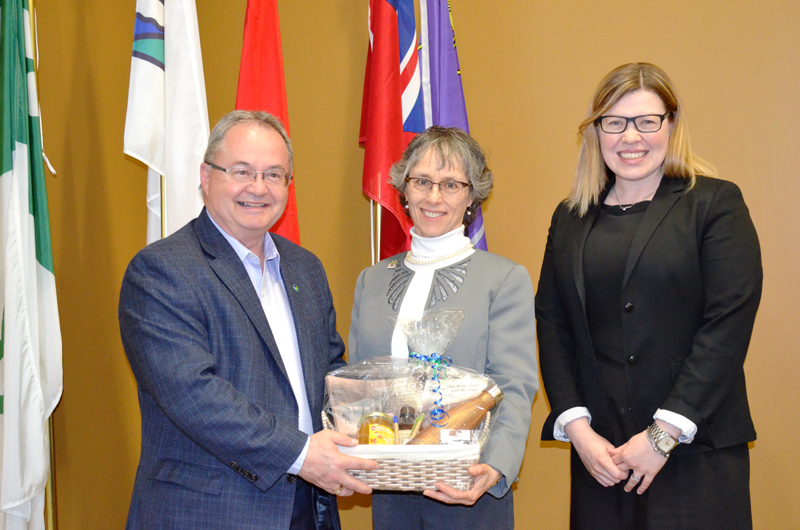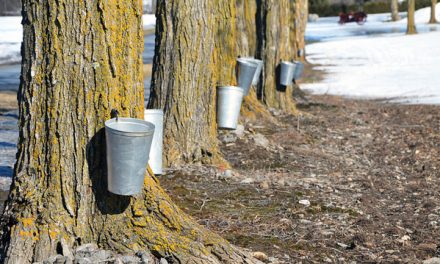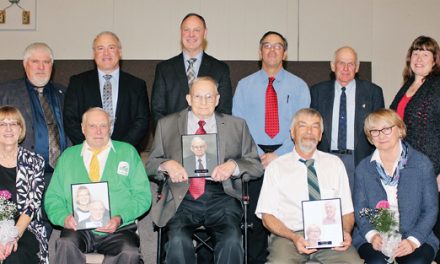Environmental Commissioner visits SNC
SNC General Manager Angela Coleman (right) and SNC Chair Francois St. Amour welcomed Dianne Saxe, the Environmental Commissioner of Ontario to the SNC office in Finch on Tues., May 9. There Rhonda Boutz gave a detailed presentation on SNC’s phosphorous trading program and John Mesman gave a presentation on loss of forest cover. Vetter photo
by Candice Vetter
AgriNews Staff Writer
FINCH — South Nation Conservation Authority welcomed Dianne Saxe, Environmental Commissioner of Ontario, to the SNC office in Finch on Tues., May 9.
There SNC Team Lead of Stewardship Rhonda Boutz gave a detailed presentation on SNC’s phosphorous trading program, which is a unique program that has potential to help reduce the amount of phosphorous leaving fields and entering waterways, and SNC Team Lead (Communications) John Mesman gave a presentation on loss of forest cover.
Boutz discussed phosphorous offsets, which are traded within the watershed only. It is a polluter-pays principle, where point source projects expected to add phosphorous to the environment, such as sewage lagoons, manure lagoons, dairy milkhouse wash water, landfills, and some industrial uses, pay a set fee of $485 per kilogram of phosphorous produced, using pre-calculated amounts. Those funds are then used for projects which enhance phosphorous retention in fields including new manure storage, milkhouse and barnyard run-off improvements, as well as livestock fencing of watercourses, water gates, and septic system upgrades.
However, buffer strips are not part of the program, although they can be very effective and are being destroyed at alarming rates throughout the watershed.
SNC’s focus is on best management practices, and on grant delivery, through the existing Clean Water Program. That operates on a peer-to-peer grant delivery basis, with farmers or retired farmers doing the visits. General Manager Angela Coleman and former GM Dennis O’Grady discussed what has made their offsets program successful, including having all the documents needed in one place and helping fill out all the forms. Saxe asked if that was crucial to the program and O’Grady said it certainly was. He also pointed out that the multi-stakeholder system of evaluating grants, with a committee composed mostly of farmers or former farmers, having a group which had worked together since 1993, was also part of the program’s success.

SNC took Environmental Commissioner Dianne Saxe (left) out in the field to examine, under the guidance of research scientist David Lapen of Agriculture and Agri-Food Canada, a gate system for drains which helps control the way and velocity which water leaves tile-drained fields. It is a simple, low-tech system, installed and managed by that department of the federal government. The system has shown a reduced phosphorous load in drains and waterways near fields. Vetter photo
The discharger has to provide the Ministry of Environment with its annual phosphorous loading. There are no environmental credits to a farmer installing a new system, as SNC retains all the credits, but SNC will often provide a grant which pays a small part of the cost. Additional funds are then usually spread around between several small projects. In the early 2000s, a large number of sewage lagoon expansion projects were built, which provided over 3,000 phosphorous credits spread over 15 years, which were spent on 10 agreements totalling over $900,000. “We’re using load-based reduction, instead of concentration,” said O’Grady. “There are pros and cons of trading but everyone agrees with the science (from peer-reviewed journals).”
Mesman then gave a short presentation about tree cover loss and the concerns about returning this area to a flood and drought cycle, like it experienced in the early 20th century after rivers were dammed and forests were clear-cut, resulting in the silting up of creeks and rivers to the point of near-desertification. In the South Nation watershed, 69 per cent of recent forest loss has been due to agriculture.
Naturally the discussion turned to flooding, and to the increased speed with which water, whether through storm water run-off systems in developments, or through tile draining of fields, is producing disastrous floods in areas which were once considered far enough from the water to be protected. Municipalities which have to respond to flooding are considering ways to mitigate the situation. Saxe noted that some areas of Ontario are experiencing flooding followed by drought, and expressed an interest in keeping more of the water on the land for use later in the year.
After the presentations, SNC GM Angela Coleman and SNC Chair Francois St. Amour presented Saxe with a gift, then SNC took her out in the field to examine, under the guidance of research scientist David Lapen of Agriculture and Agri-Food Canada, a gate system for drains which helps control the way and velocity which water leaves tile-drained fields. It is a simple, low-tech system, installed and managed by that department of the federal government. The system has shown a reduced phosphorous load in drains and waterways near fields.













